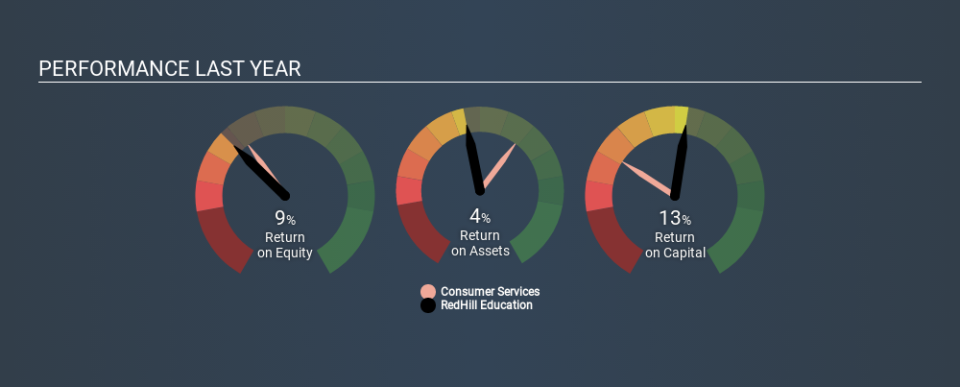Should You Like RedHill Education Limited’s (ASX:RDH) High Return On Capital Employed?

Today we'll evaluate RedHill Education Limited (ASX:RDH) to determine whether it could have potential as an investment idea. Specifically, we'll consider its Return On Capital Employed (ROCE), since that will give us an insight into how efficiently the business can generate profits from the capital it requires.
Firstly, we'll go over how we calculate ROCE. Then we'll compare its ROCE to similar companies. Then we'll determine how its current liabilities are affecting its ROCE.
What is Return On Capital Employed (ROCE)?
ROCE measures the amount of pre-tax profits a company can generate from the capital employed in its business. In general, businesses with a higher ROCE are usually better quality. In brief, it is a useful tool, but it is not without drawbacks. Author Edwin Whiting says to be careful when comparing the ROCE of different businesses, since 'No two businesses are exactly alike.
So, How Do We Calculate ROCE?
The formula for calculating the return on capital employed is:
Return on Capital Employed = Earnings Before Interest and Tax (EBIT) ÷ (Total Assets - Current Liabilities)
Or for RedHill Education:
0.13 = AU$2.6m ÷ (AU$38m - AU$19m) (Based on the trailing twelve months to June 2019.)
Therefore, RedHill Education has an ROCE of 13%.
Check out our latest analysis for RedHill Education
Is RedHill Education's ROCE Good?
ROCE can be useful when making comparisons, such as between similar companies. In our analysis, RedHill Education's ROCE is meaningfully higher than the 9.5% average in the Consumer Services industry. We consider this a positive sign, because it suggests it uses capital more efficiently than similar companies. Separate from RedHill Education's performance relative to its industry, its ROCE in absolute terms looks satisfactory, and it may be worth researching in more depth.
We can see that, RedHill Education currently has an ROCE of 13% compared to its ROCE 3 years ago, which was 5.2%. This makes us wonder if the company is improving. You can see in the image below how RedHill Education's ROCE compares to its industry. Click to see more on past growth.
It is important to remember that ROCE shows past performance, and is not necessarily predictive. Companies in cyclical industries can be difficult to understand using ROCE, as returns typically look high during boom times, and low during busts. This is because ROCE only looks at one year, instead of considering returns across a whole cycle. Future performance is what matters, and you can see analyst predictions in our free report on analyst forecasts for the company.
RedHill Education's Current Liabilities And Their Impact On Its ROCE
Current liabilities include invoices, such as supplier payments, short-term debt, or a tax bill, that need to be paid within 12 months. Due to the way ROCE is calculated, a high level of current liabilities makes a company look as though it has less capital employed, and thus can (sometimes unfairly) boost the ROCE. To check the impact of this, we calculate if a company has high current liabilities relative to its total assets.
RedHill Education has total assets of AU$38m and current liabilities of AU$19m. As a result, its current liabilities are equal to approximately 49% of its total assets. RedHill Education has a medium level of current liabilities, which would boost the ROCE.
The Bottom Line On RedHill Education's ROCE
RedHill Education's ROCE does look good, but the level of current liabilities also contribute to that. RedHill Education looks strong on this analysis, but there are plenty of other companies that could be a good opportunity . Here is a free list of companies growing earnings rapidly.
For those who like to find winning investments this free list of growing companies with recent insider purchasing, could be just the ticket.
If you spot an error that warrants correction, please contact the editor at editorial-team@simplywallst.com. This article by Simply Wall St is general in nature. It does not constitute a recommendation to buy or sell any stock, and does not take account of your objectives, or your financial situation. Simply Wall St has no position in the stocks mentioned.
We aim to bring you long-term focused research analysis driven by fundamental data. Note that our analysis may not factor in the latest price-sensitive company announcements or qualitative material. Thank you for reading.



